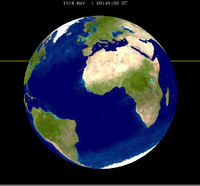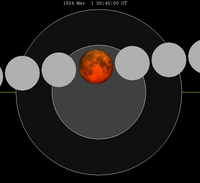
Longitude is a geographic coordinate that specifies the east–west position of a point on the surface of the Earth, or another celestial body. It is an angular measurement, usually expressed in degrees and denoted by the Greek letter lambda (λ). Meridians are imaginary semicircular lines running from pole to pole that connect points with the same longitude. The prime meridian defines 0° longitude; by convention the International Reference Meridian for the Earth passes near the Royal Observatory in Greenwich, south-east London on the island of Great Britain. Positive longitudes are east of the prime meridian, and negative ones are west.

In astronomy, the new moon is the first lunar phase, when the Moon and Sun have the same ecliptic longitude. At this phase, the lunar disk is not visible to the naked eye, except when it is silhouetted against the Sun during a solar eclipse.

In astronomy, a conjunction occurs when two astronomical objects or spacecraft appear to be close to each other in the sky. This means they have either the same right ascension or the same ecliptic longitude, usually as observed from Earth.
In astronomy and celestial navigation, an ephemeris is a book with tables that gives the trajectory of naturally occurring astronomical objects as well as artificial satellites in the sky, i.e., the position over time. Historically, positions were given as printed tables of values, given at regular intervals of date and time. The calculation of these tables was one of the first applications of mechanical computers. Modern ephemerides are often provided in electronic form. However, printed ephemerides are still produced, as they are useful when computational devices are not available.
An exeligmos is a period of 54 years, 33 days that can be used to predict successive eclipses with similar properties and location. For a solar eclipse, after every exeligmos a solar eclipse of similar characteristics will occur in a location close to the eclipse before it. For a lunar eclipse the same part of the earth will view an eclipse that is very similar to the one that occurred one exeligmos before it. The exeligmos is an eclipse cycle that is a triple saros, three saroses long, with the advantage that it has nearly an integer number of days so the next eclipse will be visible at locations and times near the eclipse that occurred one exeligmos earlier. In contrast, each saros, an eclipse occurs about eight hours later in the day or about 120° to the west of the eclipse that occurred one saros earlier.

Pharaoh is the fourth and last major novel by the Polish writer Bolesław Prus (1847–1912). Composed over a year's time in 1894–95, serialized in 1895–96, and published in book form in 1897, it was the sole historical novel by an author who had earlier disapproved of historical novels on the ground that they inevitably distort history.

Abraham Zacuto was a Castilian astronomer, astrologer, mathematician, rabbi and historian who served as Royal Astronomer to King John II of Portugal.

Bernhard Walther was a German merchant, humanist and astronomer based in Nuremberg, Germany.
This is a list of fictional stories in which solar eclipses feature as an important plot element. Mere passing mentions are not listed.

A solar eclipse occurs when the Moon passes between Earth and the Sun, thereby obscuring the view of the Sun from a small part of Earth, totally or partially. Such an alignment occurs approximately every six months, during the eclipse season in its new moon phase, when the Moon's orbital plane is closest to the plane of Earth's orbit. In a total eclipse, the disk of the Sun is fully obscured by the Moon. In partial and annular eclipses, only part of the Sun is obscured. Unlike a lunar eclipse, which may be viewed from anywhere on the night side of Earth, a solar eclipse can only be viewed from a relatively small area of the world. As such, although total solar eclipses occur somewhere on Earth every 18 months on average, they recur at any given place only once every 360 to 410 years.

The Moon orbits Earth in the prograde direction and completes one revolution relative to the Vernal Equinox and the stars in about 27.32 days and one revolution relative to the Sun in about 29.53 days. Earth and the Moon orbit about their barycentre, which lies about 4,670 km (2,900 mi) from Earth's centre, forming a satellite system called the Earth–Moon system. On average, the distance to the Moon is about 385,000 km (239,000 mi) from Earth's centre, which corresponds to about 60 Earth radii or 1.282 light-seconds.
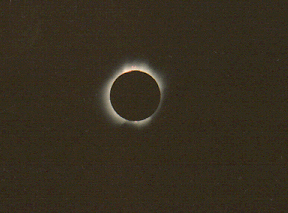
A total solar eclipse occurred at the Moon’s descending node of the orbit on Thursday, July 11, 1991. A solar eclipse occurs when the Moon passes between Earth and the Sun, thereby totally or partly obscuring the image of the Sun for a viewer on Earth. A total solar eclipse occurs when the Moon's apparent diameter is larger than the Sun's, blocking all direct sunlight, turning day into darkness. Totality occurs in a narrow path across Earth's surface, with the partial solar eclipse visible over a surrounding region thousands of kilometres wide. Totality began over the Pacific Ocean and Hawaii moving across Mexico, down through Central America and across South America ending over Brazil. It lasted for 6 minutes and 53.08 seconds at the point of maximum eclipse. There will not be a longer total eclipse until June 13, 2132. This was the largest total solar eclipse of Solar Saros series 136, because eclipse magnitude was 1.07997.

A penumbral lunar eclipse took place on Thursday, 18 August 2016. It was the second of three lunar eclipses in 2016. This was 3.7 days before the Moon reached perigee. There are multiple ways to determine the boundaries of Earth's shadow, so this was a miss according to some sources. The HM National Almanac Office's online canon of eclipses lists this event as the last eclipse on Saros Series 109, while NASA lists August 8, 1998 as the last eclipse of the series, and has this event missing the shadow.

A total solar eclipse will occur on Saturday, August 12, 2045, when the Moon passes between Earth and the Sun, thereby totally or partly obscuring the image of the Sun for a viewer on Earth. A total solar eclipse occurs when the Moon's apparent diameter is larger than the Sun's, blocking all direct sunlight, turning day into darkness. Totality occurs in a narrow path across Earth's surface, with the partial solar eclipse visible over a surrounding region thousands of kilometres wide.
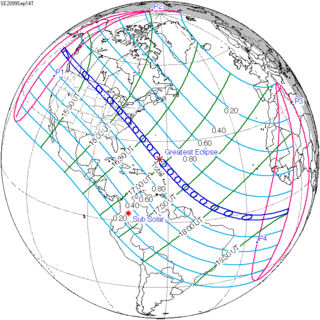
A total solar eclipse will occur on Monday, September 14, 2099. A solar eclipse occurs when the Moon passes between Earth and the Sun, thereby totally or partly obscuring the image of the Sun for a viewer on Earth. A total solar eclipse occurs when the Moon's apparent diameter is larger than the Sun's, blocking all direct sunlight, turning day into darkness. Totality occurs in a narrow path across Earth's surface, with the partial solar eclipse visible over a surrounding region thousands of kilometres wide.

An annular solar eclipse occurred at the moon's descending node of its orbit on Tuesday, May 10, 1994. It was visible over a wide swath of North America, from Baja California across the Midwest of the United States up through Ontario and Nova Scotia in Canada. Occurring only 1.6 days after apogee, the moon's apparent diameter was smaller than the sun. This solar eclipse belonged to Saros series 128.
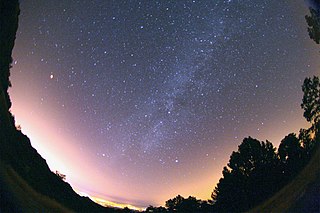
Some eclipses of the Moon are mentioned in historical accounts in connection with a significant event. Lunar eclipses are somewhat rare events, although not as rare as solar eclipses, because unlike solar eclipses they can be viewed from anywhere on the dark side of the Earth. Throughout history lunar eclipses have been held to be responsible for lost battles, and have helped make possible extraordinary escapes.
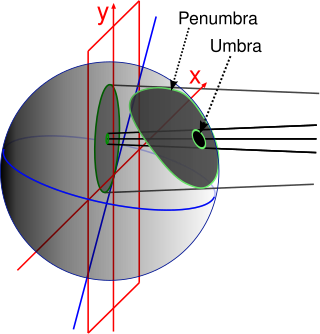
The Besselian elements are a set of values used to calculate and predict the local circumstances of occultations for an observer on Earth. This method is particularly used for solar eclipses, but is also applied for occultations of stars or planets by the Moon and transits of Venus or Mercury. In addition, for lunar eclipses a similar method is used, in which the shadow is cast on the Moon instead of the Earth.

Santiago was a Spanish territory of the Spanish West Indies and within the Viceroyalty of New Spain, in the Caribbean region. Its location is the present-day island and nation of Jamaica.
Maya astronomy is the study of the Moon, planets, Milky Way, Sun, and astronomical phenomena by the Precolumbian Maya Civilization of Mesoamerica. The Classic Maya in particular developed some of the most accurate pre-telescope astronomy in the world, aided by their fully developed writing system and their positional numeral system, both of which are fully indigenous to Mesoamerica. The Classic Maya understood many astronomical phenomena: for example, their estimate of the length of the synodic month was more accurate than Ptolemy's, and their calculation of the length of the tropical solar year was more accurate than that of the Spanish when the latter first arrived. Many temples from the Maya architecture have features oriented to celestial events.

